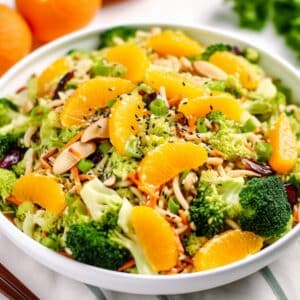
This light salad is easy to make for lunch at school, work or home.
Looking for a fresh and healthy salad? Try this Mandarin and Greens Salad! Packed with nutritious ingredients like red leaf lettuce, watercress, broccoli, and mandarins, and topped with a tangy dressing made with rice vinegar, orange zest, and low sodium soy sauce, this salad is a flavorful and satisfying meal option.

Mandarin Oranges: The Diabetes-Friendly Citrus Powerhouse
Mandarin oranges, also known as clementines, are a type of citrus fruit that are low in calories and high in nutrients. They are a great source of vitamin C, which supports a healthy immune system, and vitamin A, which is important for eye health. They also contain folate, potassium, and dietary fiber.
In terms of glycemic index and glycemic load, mandarin oranges have a low glycemic index of 40, which means they do not cause a rapid spike in blood glucose levels. They also have a low glycemic load, which takes into account both the glycemic index and the carbohydrate content of the food, making them a good option for people living with diabetes.
Additionally, the dietary fiber found in mandarin oranges can help regulate blood glucose levels by slowing down the absorption of carbohydrates in the bloodstream. This can be especially beneficial for people with type 2 diabetes.
Overall, mandarin oranges can be a nutritious and diabetes-friendly addition to a healthy diet.
How to Shop and Store the Masterful Mandarin Orange
Mandarin oranges are typically in season from November through March, with peak availability in December and January. When shopping for mandarin oranges, look for fruits that are firm, heavy for their size, and have a bright orange color. Avoid fruits with soft spots or blemishes, as these may be a sign of decay.
Mandarin oranges can be stored at room temperature for a few days or in the refrigerator for up to two weeks. If storing at room temperature, it is best to keep them in a cool, dry place away from direct sunlight. If storing in the refrigerator, place them in a plastic or mesh bag to allow for air circulation and to prevent moisture buildup, which can cause spoilage.

Broccoli: The Cruciferous Veggie with Diabetes-Fighting Benefits
Broccoli is a cruciferous vegetable that is low in calories and high in nutrients. It is an excellent source of vitamin C, vitamin K, and dietary fiber. It also contains folate, potassium, and vitamins B6 and B2.
As a cruciferous vegetable, broccoli contains compounds called glucosinolates, which have been linked to numerous health benefits. When broken down during digestion, these compounds form bioactive substances such as indoles, isothiocyanates, and sulforaphane, which have anti-inflammatory, antioxidant, and anti-cancer properties.
Sulforaphane, in particular, has been studied for its potential role in improving insulin sensitivity and reducing the risk of type 2 diabetes. Research has shown that sulforaphane can activate enzymes that improve glucose metabolism and reduce oxidative stress, which are key factors in the development of diabetes and its complications.
Broccoli is also high in fiber, which can help regulate blood glucose levels by slowing down the absorption of carbohydrates in the bloodstream. This can help prevent spikes and crashes in blood glucose levels, which can be especially beneficial for people with diabetes.
In addition to its potential benefits for diabetes, broccoli has been linked to numerous other health benefits, including improved heart health, reduced cancer risk, and better digestive function. Adding broccoli to your diet is an easy and delicious way to boost your nutrient intake and support overall health and well-being.

Shopping for Broccoli
When shopping for broccoli, look for firm, tightly-packed heads with a deep green color and no yellowing or soft spots. The stem should also be firm and not too woody. Broccoli can be sold both with and without leaves, but either way, the leaves should look fresh and vibrant.
Once you've selected your broccoli, it's important to store it properly to prevent spoilage. Broccoli can be stored in the refrigerator for up to 5-7 days. To store, wrap the broccoli in a damp paper towel and place it in a plastic bag or airtight container. This will help to prevent the broccoli from drying out and becoming tough.
To prepare broccoli, remove any leaves and trim off the bottom of the stem. You can then either break the broccoli into bite-sized florets or slice the stem and florets into smaller pieces. Broccoli can be eaten raw or cooked in a variety of ways, including steaming, roasting, stir-frying, or sautéing.
Overall, broccoli is a versatile and nutritious vegetable that is easy to prepare and incorporate into your diet. By following these simple tips for shopping, selecting, and storing broccoli, you can ensure that you are getting the freshest and most flavorful broccoli possible.


Mandarin and Greens Salad
Ingredients
For the Salad
- 4 cups red leaf lettuce - chopped
- 1 cup watercress - chopped
- 1 medium carrot - peeled and grated
- 3 mandarins - peeled and sections separated
- 1 medium English cucumber - sliced on a slight angle
- 1 tsp sesame seeds - dry toasted
- 2 tbsp raisins
- 1/2 cup alfalfa sprouts - washed and dried thoroughly
- 1 head broccoli - chopped
- 1/2 cup brown rice - cooked
For the Dressing
- 1/4 cup rice vinegar
- 1 tbsp orange zest
- 1/4 tsp black pepper
- 1 tbsp low-sodium soy sauce
- 1 juice from mandarin
Instructions
- In a small container with a tight lid place all the ingredients for the dressing. Shake well and set aside.
- In a large bowl or container, place all the salad ingredients and toss so all the ingredients are well mixed. If you are taking this salad to school or work, just layer the ingredients and toss it before eating and adding the dressing.

